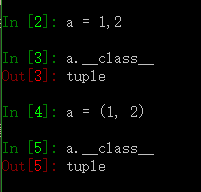Python:语句表达式(code structure)
1. 赋值
普通赋值
多重赋值
举一个多重赋值的列子:
a, b = b, a简单的语句实现了变量值的交换,但是这里需要注意的是,这样的赋值其实是运用了元组的赋值,因为在python中,‘,’是生成元组的标志,而不是圆括号,下图可以说明:
2. 输入语句
raw_input():
输入的内容当作字符串复制给变量
input():
输入的内容为Python可执行的语句,从而将计算后的结果作为值赋给变量
3. 输出语句
python2:
在python2中,print是一个语句
- print a,b
- print>>file,a,b:把a,b打印到文件中
- print '%d,%d,%s'%(a,b,c):和c中一样,a,b以数字的形式,c以字符串的形式打印
- print "{0} like {1}".format('we','python'):加强可读性
- print "{a} like {b}".format(a='we',b='python'):可读性更强
python3:
在python3中,print是一个函数
- print([obj, ...] [,sep=''] [,end='\n'] [,file=sys.stdout])
4. 条件语句
语法:
#---------语句中的xxx代表逻辑表达式
if xxx:
statements1
elif xxx:
statements2
else:
statements3其他
- 逻辑表达式
- `not`
- `and`:返回第一个`false`或者最后一个`true`
- `or`:返回第一个`true`或者最后一个`false`
- 三元表达式
- `a=y if x>o else z`
5. 循环语句
while/else语句
while xxx:
statements1
if xxx:
break/continue
else:
statements2 #如果上面的循环体是自然结束而不是break跳出的话就会执行这条else里的内容for语句
for x in objects:
statements1
if xxx:break/continue
else:
statements2一些循环体运用的例子
#!/usr/bin/env python
# coding: utf-8
#copyRight by heibanke
# 打印[10-0]之间的偶数
x = 10
while x:
if x % 2 == 0: # Even?
print x
x = x-1
# 判断是否素数(质数):大于1的自然数,除1和它本身外没有整数能够整除
y=input()
x = y // 2
while x > 1:
if y % x == 0:
print y, 'has factor', x
break
x -= 1
else: # Normal exit
print y, 'is prime number'
####################### for ###########################
sum = 0
for x in [1, 2, 3, 4]:
sum += x
S = u"你在远方"
T = (u"我", u"在", u"故乡")
for x in S: print x,
for x in T: print x,
file = open('test.txt','w')
D = {'a': 1, 'b': 2, 'c': 3}
for key in D:
print >>file, key, '=>', D[key]
file.close()
#####################################################
items = [u"小方", u"小白", u"小三", u"小王"] # A set of objects
key = u"小李" # Keys to search for
for item in items: # For all items
if item == key: # Check for match
print key, "was found"
break
else:
print key, "not found!"
#####################################################
file = open('test.txt')
while True:
line = file.readline() # Read line by line
if not line: break
print line.strip() # Line already has a \n
file.close()
for line in open('test.txt'):
print line.strip()6. 列表解析
A comprehension is a compact way of creating a Python data structure from one or more iterators. Comprehensions make it possible for you to combine loops and conditional tests with a less verbose syntax. Using a comprehension is sometimes taken a sign that you know Python at more than a beginner’s level. In other words,it’s more Pythonic.
List Comprehensioins
- 最简单的形式:
[ expression for item in iterable ] - 可以加上条件语句:
[ expression for item in iterable if condition]
举个列表解析的例子:
rows = range(1,4)
cols = range(1,3)
cells = [(row, col) for row in rows for col in cols]
for cell in cells:
print(cell)
#最后的输出结果:
#(1,1)
#(1,2)
#(2,1)
#...就不全列出来了需要说明的是两个for循环都可以有自己的if条件
Dictionary Compresion
- 最简单的形式:
{key_expression: value_expression for expression in iterable} - 当然同样可以加上
if条件
同样来看一个字典解析的例子:
word = 'letters'
letter_counts = {letter : word.count(letter) for letter in word}
print letter_counts
#结果是:{'l':1, 'e':2, 't':2, 'r':1, 's':1}在这个程序里,我们遍历了'letters'这个字符串,统计了不同字母出现的次数,在字母e和字母t处我们重复使用了两次count()函数,造成了浪费,这是,我们可以对字典解析部分做点改动,使得程序更加的Pythonic:
letter_counts = {letter : word.count(letter) for letter in set(word)}
#这时再打印letter_counts得到的结果是:{'t':2, 'l':1, 'e':2, 'r':1, 's':1}利用set()我们避免了重复计数,但是细心地查看输出结果可以发现打印出来的Key的顺序变了,这是由于set()之后存储方式变了。
Set Comprehensions
- 一般形式为:
{expression for expression in iterable}
Generator Comprehensions
- 需要注意的是并没有元组解析,虽然Generator Comprehensions看起来像是
举个例子:
number_thing = (number for number in range(1, 6))以上就是Generator Comprehension的形式,注意这不是元组解析,因为当你使用type(number_thing)之后你会得到类型为<class 'generator'>。Generator Comprehension是想遍历器提供数据的一种方式。
A generator can be run only once. Lists, sets, strings, and dictionaries exists in menory, but a generator creates its values on the fly and hands them out one at a time through an iterator. It doesn’t remember them,so you can’t restart or back up a generator.
7. 异常处理
基本形式为:
try:
statements 1
except:
statements 2这里单单用了一个expect,没有传递任何参数,将会响应任何异常,如果需要指定一些异常,并且向要得到关于异常的细节,那我们可以这样写:
expect expectiontype as name8. 作业
设计一个小游戏-猜数字:
- 随机产生要猜的数字
- 输入,用于接收用户输入的数字
- 循环,如果没猜对则循环接收输入,并打出提示信息
- 猜到数字或猜测次数达到一定次数后(6次)打印失败并推出
改进猜数字游戏,防作弊,错误输入判断
利用上次用户密码作业,请模拟注册过程:用户输入用户民之后进行检测用户名是否在文件中的过程。并返回合理的错误提示。如果不在则输入密码,成功则增加用户信息到文件中,密码进行md5加密处理
增加用户名,密码的合法化判断和错误提示
- 用户名:字母,数字,下划线和横线的组合,且首字符应是字母,长度不小于4
- 密码:字母,数字,下划线和横线的组合,且长度不小于6
继续上一课的公交系统作业,利用循环语句将所有线路的linenum和stations保存到一个字典对象;执行后提示输入公交站名字,在所有公交线路的stations里查询该名字,并将包含有该名字的公交线路存到一个字典进行返回
9. 作业答案
- Solution:
#!/usr/bin/python
#coding:utf-8
import random
num = random.randint(0, 100)
count = 6
flag = True
while count:
flag = True
while flag:
try:
input_num = input("0-100,please choose a number[q to quit]\n")
flag = False
except:
print 'something wrong,you should input a number'
continue
if input_num > num:
print 'you num is too big,', 'chances left: ', count-1
elif input_num < num:
print 'you num is too small,', 'chances left: ', count-1
elif str(input_num) == r'num':
print 'please do not cheat, ', 'chances left: ', count-1
else:
print 'you did a good job'
break
count -= 1
else:
print 'it a pity! game over~~ and secret number is ', num- Solution:
#!/usr/bin/python
#coding:utf-8
#copyRight by TristanHuang
import random
num = random.randint(0, 100)
count = 6
while count:
try:
input_num_str = raw_input("0-100,please choose a number[q to quit]\n")
if input_num_str == 'q':
break
input_num=int(input_num_str)
except:
print 'something wrong,you should input a number'
continue
if input_num > num:
print 'you num is too big,', 'chances left: ', count-1
elif input_num < num:
print 'you num is too small,', 'chances left: ', count-1
else:
print 'you did a good job'
break
count -= 1
else:
print 'it a pity! game over~~ and secret number is ', num- Solution:
- Solution:
#!/usr/bin/env python
#coding: utf-8
#__author__ = 'Tristan'
#初始化账号数据缓存
data = list()
#先读取账号文件的所有记录
f = open('account.txt', 'r')
for line in f:
a = line.split(',') #读取一行的账号和密码
data.append(a[0]) #记录账号到缓存中
print data
character = 'ABCDEFGHIJKLMNOPQRSTUVWXYZabcdefghijklmnopqrstuvwxyz0123456789-_'
first_c = 'ABCDEFGHIJKLMNOPQRSTUVWXYZabcdefghijklmnopqrstuvwxyz'
while True:
print u"--------注册--------\n"\
+ u"请输入用户名(首字母必须为字母,最小长度为4, 大小写字母,数字,_,-,的组合)\n"
name =raw_input()
accountValid = True
#核查用户名的有效性
if len(name) < 4:
print u"你的输入%s不够4位, 请重新输入!" % (name)
accountValid = False
elif not name[0] in first_c:
print u"你的输入%s首字符必须是字母, 请重新输入!" % (name)
accountValid = False
else:
#检查是否已存在
if name in data:
print u"这个用户名%s已经存在,请重新输入!"%(name)
valid = False
flag = True
# 密码是否有效
while flag and accountValid:
print u"该用户名可以使用,请输入密码(最小长度为6, 大小写字母,数字,_,-,的组合):\n"
password = raw_input()
#检查是否有效
if len(password)<6:
print u"你的输入密码%s不够6位, 请重新输入!"%(password)
continue
for a in password:
if not a in character:
print u"你的输入密码%s有非法字符, 请重新输入!"%(password)
flag=True
break
else:
flag = False
#写入账号信息
if accountValid and (not flag):
file = open('account.txt', 'a')
#md5数据加密
import hashlib
password_md5 = hashlib.md5(password).hexdigest()
file.write(name+','+password_md5+'\n')
file.close()
print u"恭喜你,注册成功"
break
























 1万+
1万+

 被折叠的 条评论
为什么被折叠?
被折叠的 条评论
为什么被折叠?








